Sauntering down Taipei’s Zhenjiang Street (鎮江街), unsuspecting pedestrians are lured by a seductive scarlet carpet in front of what appears as a humble and rather mundane apartment — an abode that houses the only vegetarian restaurant in Taiwan on Michelin’s Bib Gourmand list: Serenity.
Aside from the restaurant’s pronounced store sign, its interior is almost entirely pigmentless, perhaps to highlight the vibrant colors of each exquisite dish. The anterior of the restaurant, enclosed in floor-to-ceiling glass panes, allows sunlight to be radiated onto every corner, creating a bright and invigorating atmosphere.
The interior decor consists of pale white walls, polished dark-brown wooden seats, and ordinary rectangular and round tables; though seemingly drab, such arrangement imbues a homey image that possibly leaves some reminiscing about their childhood.
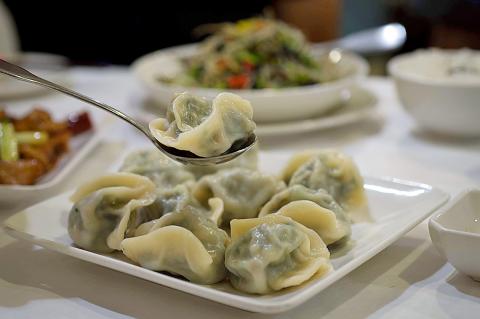
Photo: Vanessa Tsao
As our group of four waited to be seated, we couldn’t help but notice a spicy aroma coming from the kitchen. It turns out, this otherworldly scent was merely a byproduct of artwork jointly produced by two expert chefs, one specializing in Sichuan cuisine and the other in vegetarian cooking. With innovative mindsets, the two aim to intermix vegetarian ingredients with traditionally meat-based Sichuan flavors.
The waitress, who momentarily greeted us as we sat down, proudly introduced signature dishes on their 100-item long, full-vegetarian menu. Their menu, however extensive, was unfit for our indecisive minds; we ended up adhering to the waitress’s suggestions and ordered five dishes plus four bowls of rice.
The first to arrive was house-made vegetarian dumplings (NT$160). The dumplings are composed of a blend of finely shredded pickled cabbage, translucent vermicelli and diced mushrooms wrapped in a thin sheet of flour dough. The restaurant’s generous use of fresh, quality ingredients is evident in every bite; dipping in mild soy sauce adds an extra hint of savoriness. A Taiwanese staple, these boiled dumplings were the perfect preamble to the hearty dishes that follow.
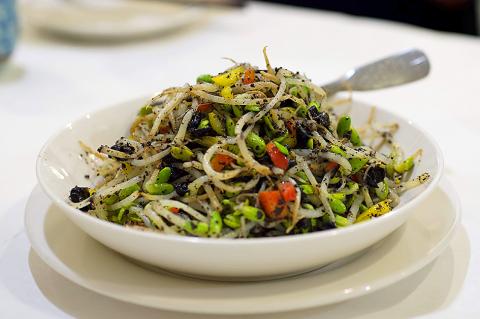
Photo: Vanessa Tsao
Then came the black bean sprouts in truffle sauce (NT$300), sauteed vermicelli with spicy vegetarian minced meat (NT$220) and vegetarian kungpao chicken (NT$220).
The bean sprouts feature assorted greens: crunchy young green sprouts, black beans, roughly diced yellow and red bell peppers tossed in an earthy truffle pate. To our surprise, the distinct flavors of constituent ingredients were not overshadowed by the truffle, which is usually indicative of the chef’s technique and precision.
The vermicelli, commonly known as “Ants climbing up a tree” (螞蟻上樹), is sauteed with bits of shiitake mushrooms, celery, chili peppers, soy-based minced pork in a piquant Sichuan spice blend and topped with aromatic coriander. The fiery vermicelli danced on our tongues. It sure was a tad spicy — though we had been warned. For those not used to firey Sichuan food, a reduction of spice is recommended.
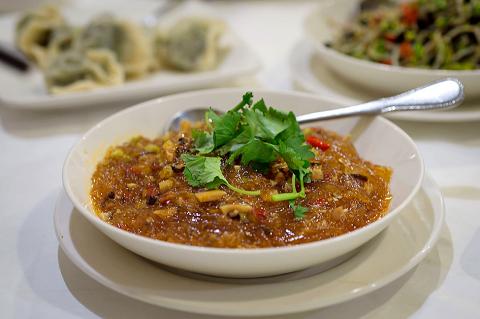
Photo: Vanessa Tsao
Of the three, the dish that really stood out for me was the soy and wheat infused kungpao “chicken.” Stir-fried with hollow Chinese chili, firm spring onions, peanuts and veiled by a tangy fragrant chili sauce, everything on that dish glistened. Juices in the chicken bursted with every bite. Needless to say, white rice harmonized with these Sichuan flavors.
The finale to such a scrumptious vegetarian meal was the impressive squid balls. The mixture of soy, wheat and what seems to have the texture of seitan or tofu is stuffed in cremini mushroom and deep fried to golden-brown perfection. They are seasoned with a dash of pepper salt and lie atop a bed of crispy basil leaves. These plant-based squid balls tasted so similar to actual squid balls that I forgot they were completely vegetarian.
We probably should have ordered their much-lauded steamed stinky tofu. I’ll definitely come back, though. The price was unbelievably fair (four overfull stomachs costed NT$1,408); no wonder this restaurant was featured on the Michelin guide’s Bib Gourmand section.
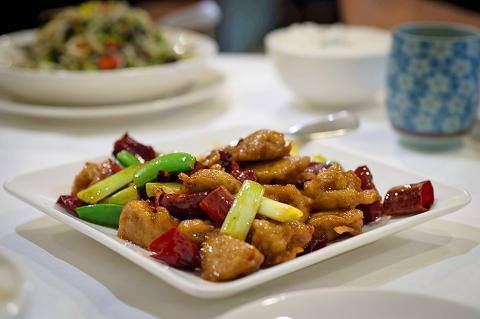
Photo: Vanessa Tsao
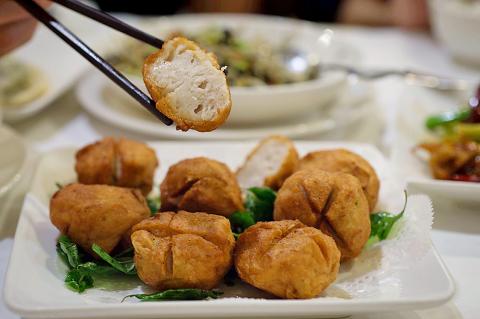
Photo: Vanessa Tsao

April 14 to April 20 In March 1947, Sising Katadrepan urged the government to drop the “high mountain people” (高山族) designation for Indigenous Taiwanese and refer to them as “Taiwan people” (台灣族). He considered the term derogatory, arguing that it made them sound like animals. The Taiwan Provincial Government agreed to stop using the term, stating that Indigenous Taiwanese suffered all sorts of discrimination and oppression under the Japanese and were forced to live in the mountains as outsiders to society. Now, under the new regime, they would be seen as equals, thus they should be henceforth

Last week, the the National Immigration Agency (NIA) told the legislature that more than 10,000 naturalized Taiwanese citizens from the People’s Republic of China (PRC) risked having their citizenship revoked if they failed to provide proof that they had renounced their Chinese household registration within the next three months. Renunciation is required under the Act Governing Relations Between the People of the Taiwan Area and the Mainland Area (臺灣地區與大陸地區人民關係條例), as amended in 2004, though it was only a legal requirement after 2000. Prior to that, it had been only an administrative requirement since the Nationality Act (國籍法) was established in

Three big changes have transformed the landscape of Taiwan’s local patronage factions: Increasing Democratic Progressive Party (DPP) involvement, rising new factions and the Chinese Nationalist Party’s (KMT) significantly weakened control. GREEN FACTIONS It is said that “south of the Zhuoshui River (濁水溪), there is no blue-green divide,” meaning that from Yunlin County south there is no difference between KMT and DPP politicians. This is not always true, but there is more than a grain of truth to it. Traditionally, DPP factions are viewed as national entities, with their primary function to secure plum positions in the party and government. This is not unusual

The other day, a friend decided to playfully name our individual roles within the group: planner, emotional support, and so on. I was the fault-finder — or, as she put it, “the grumpy teenager” — who points out problems, but doesn’t suggest alternatives. She was only kidding around, but she struck at an insecurity I have: that I’m unacceptably, intolerably negative. My first instinct is to stress-test ideas for potential flaws. This critical tendency serves me well professionally, and feels true to who I am. If I don’t enjoy a film, for example, I don’t swallow my opinion. But I sometimes worry